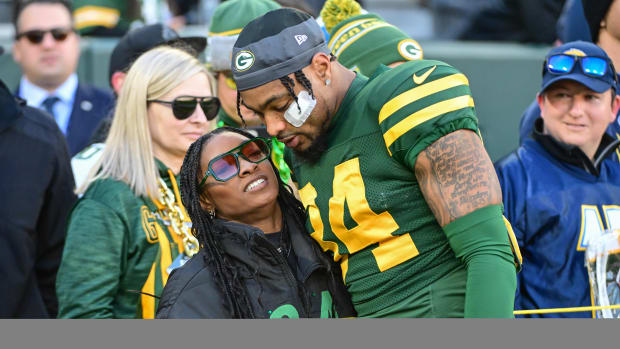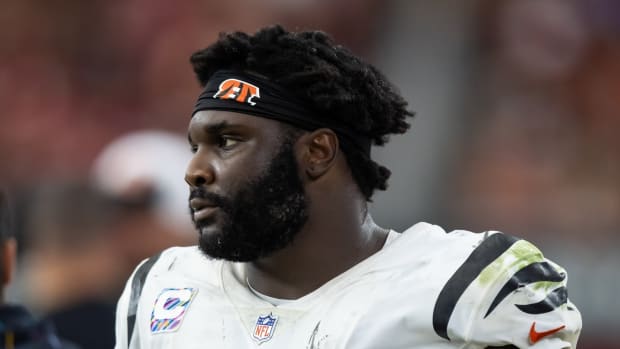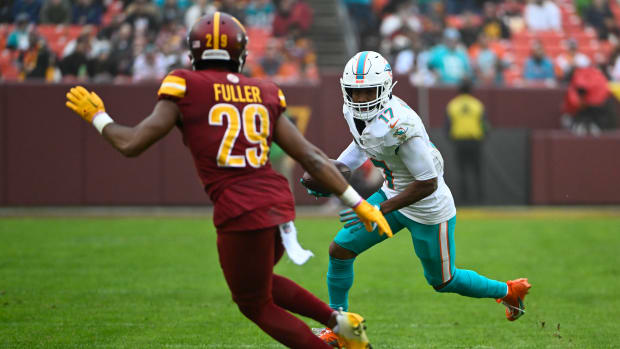The Math Behind the Wide Receiver Blockbusters
Another wild week, so we’re going with another notes-style GamePlan column …
I had a really interesting conversation on Thursday morning with an NFC exec who has a pro scouting background. Over the course of a half-hour, we talked through what’s turned out to be the top storyline on this offseason’s undercard, behind only the big-box quarterback moves of the last month, and that’s what has gone with receivers over the last week or so.
“So, and this is my opinion, when you have a high-priced quarterback, it’s hard to have a high-priced receiver,” the exec said. “Miami has a young quarterback on a rookie deal and they trade for [a high-priced receiver]. Which leads me to believe the inverse is going to be true of Green Bay—I think in the draft, they’ll go outside their normal trend, and take a receiver. Look at what Vegas is doing—swinging hard out of the gate, Josh is the new head coach, and he’s not used to being in a losing situation.
“At some point, that will have to correct itself.”
The exec then pointed out that if you take Raiders QB Derek Carr’s average per year—$25 million—and add it to the real value of Davante Adams’s deal ($23.5 million per over the first three years of his deal), you’re basically at what Aaron Rodgers, Patrick Mahomes and Deshaun Watson now cost. And with Carr in a contract year, he’d either have to take a team-friendly deal, or the correction’s coming, eventually.
That, of course, isn’t to say receivers aren’t valuable anymore. To the contrary—because of the rise in the importance of the passing game, they matter more than they ever have.
But the exec’s point was it’s no coincidence that the two elite receivers changing teams, Adams and Tyreek Hill, are going from organizations that have quarterbacks on market-topping contracts (Rodgers and Mahomes) to teams that have quarterbacks on more affordable deals (Carr and Tua Tagovailoa).
Mahomes’s cap number, by the way, jumps from $7.433 million to $35.79 million this year, and will be well over $40 million (and into 50s in three seasons), every year from here through 2031. And even after Green Bay did a ton of cap gymnastics, Rodgers’s number is $28.53 million this year, $31.62 million next year, and into the 40s after that. Fact is, carrying that weight at one position means having to get some pounds back somewhere else.
Now ask yourself this—based on recent drafts, is it easiest to find a receiver, a corner, a left tackle or a pass-rusher? Without question, because of the amount of top athletes wanting to play the position, and the proliferation of 7-on-7 with school-aged kids, and the passing game in both high school in college, finding a great receiver has become much easier than finding a great pass-rusher or left tackle or corner.
And sure, because everyone’s throwing it so much, you can say finding a great receiver is vital in today’s game. But it’s no more important than finding guys to fill those other roles.
“Quarterback is the most valued position, and because of that, you have to do two things—protect him, and go get him,” the exec continued. “Those premiums are higher now than they’ve ever been. That puts a team like Jacksonville in a quagmire. They just took Trevor, and now they have No. 1 again—so do you pick the guy to protect him or the edge rusher to get the other team’s guy?”
Long-term, that decision will, of course, loom large, because Aidan Hutchinson, or Evan Neal or Ikem Ekwonu, could give the Jaguars another premium-position star at a rookie-contract rate. And as for the Packers and Chiefs, on the other end of this equation? Their bet is that with all that draft capital, and another deep, talented crew of receivers available in the draft, they’ll be able to find suitable options for Rodgers and Mahomes.
Along those lines, it’s no coincidence that the decisions on Adams and Hill are coming at a time when those teams need to be careful of those “other” positions. The Chiefs are trying to strike a long-term deal with their left tackle, Orlando Brown Jr., while the Packers have corner Jaire Alexander looking for a new deal this year, and burgeoning star edge rusher Rashan Gary in line to get one either this year or next.
So in the end, I don’t think the decision for either team was easy. It was simply what was best—for the makeup of the roster as a whole and, in the end, probably for the quarterbacks themselves too.
• Still, the deal, to me, makes all the sense in the world if you’re the Dolphins.
If recent history tells us anything, under the current economic system for rookies (which stretches back to the 2011 draft class), you want to have an answer on your first-round quarterback after three years. Deshaun Watson and Patrick Mahomes were extended after three years. Josh Allen was, too. Sam Darnold, conversely, was dealt after his third year, and Kyler Murray is being forceful about a new deal now, after his third year.
It's the juncture at which the players are first eligible for second contracts, and when teams have to make decisions, absent extensions, on those players’ fifth-year options. Kicking the can down the road a year sometimes works—Lamar Jackson has been fine for the Ravens going through that. But he’s more the outlier. More often, the situation becomes like Baker Mayfield’s, where both sides are in an awkward no-man’s-land.
That brings us back to Miami, and Tagovailoa. The Dolphins are a year away from that crossroads with the fifth overall pick from the 2020 draft. New coach Mike McDaniel, for better or worse, is going to need to get answers quickly on Tagovailoa, with big decisions looming a year from now.
Trading for Hill, and signing premier left tackle Terron Armstead, will help the Dolphins gain clarity on Tagovailoa. The excuses are gone. Miami has invested in every position group on offense, and hired a coach who’s a Ph.D in the scheme that most of the league wants to run. What’s more, having Hill and Jaylen Waddle together should play right into Tagovailoa’s wheelhouse—at Alabama, he was at his best in the RPO game, playing instinctively, and getting the ball out fast to human sticks of dynamite.
He was perfect for that loaded Bama receiving corps because his game was best setting the stage for others to do something dynamic with the balls in their hands. And he should have that again now.
If it works, great. If it doesn’t, well, then Miami gets its answer. In that way, Hill will help them get to it faster than he can get to the end zone.
• There are two other important things to take from these receiver negotiations.
The first comes in how you read contracts. Hill’s deal was touted as a four-year, $120 million extension. On paper, it is. But the truth is Hill’s deal really is a three-year, $75 million agreement, and then … we’ll see. And that’s still as good a contract as any receiver has ever gotten (better than DeAndre Hopkins, better than Julio Jones) through three years. Same goes for the Adams deal, which was touted as a five-year, $141.25 million deal, but is actually really a three-year agreement for $67.5 million.
Again, these are very good deals, especially when you consider they’re third deals for both players. But they aren’t what, say, T.J. Watt got last year.
The second piece of this is how each negotiation affects another. There was a lot of back-and-forth between Hill and the Chiefs, and at times optimism that something would get done. But Adams’s deal worked to define the market, and Hill’s insistence that he beat Adams by every metric pushed Kansas City toward the conclusion that they’d be better off with the picks coming back the next two years, and about $70 million in cap space over the next three years.
• Speaking of quarterback economics, the Matt Ryan/Carson Wentz deal is a financial wash for the Colts—Wentz is due $52.0 million over the next two years, while Ryan is getting $53.9 million. Add that to the fact that Indianapolis gave up the 82nd pick for Ryan, while getting the 73rd pick, a third-rounder that’ll likely become a second-rounder, and moving their second-rounder up from 47 to 42 in the Wentz deal, and this is a big win for the Colts.
Yes, the Colts got older, but they also got better at quarterback, and that serves a team loaded with win-now players (Quenton Nelson, Darius Leonard, Jonathan Taylor, etc.). And they did it while improving their second- and third-round positions this year, and adding a top-100 pick next year.
Now, before we give the team too much credit, giving up last year’s third-rounder and this year’s first (16th overall) for Wentz created this problem in the first place, and no one would call last year’s trade for Wentz a win. But overall, when you tally it up, this was a really nice recovery by Colts GM Chris Ballard.
• You’re going to hear a lot about overtime over the next week, with the NFL Annual Meeting set for Palm Beach starting on Sunday. And here’s the argument I keep hearing on changing it—that football is a three-phase game, and there should be value in a team’s ability to make a defensive stop.
Of course, the way the Patriots sliced through the Chiefs in the 2018 AFC title game, and the way the Chiefs ripped through the Bills in this year’s divisional playoff, supports the argument that today’s offenses are always going to have the edge in these situations against worn-out defense with rules skewed to handicap them. The other side would remind you that in the AFC title game, the Bengals leaned on all three phases to beat those same Chiefs.
I expect it will be a robust one. And one thing to remember is that these sorts of rules changes can sometimes take a few years to gain the traction needed to be voted through—with a three-quarters approval rate needed.
• I like the role that Cowboys coach Mike McCarthy has created on his staff, first for Ben McAdoo, and now for Brian Schottenheimer—a sort of over-the-top role to be filled by an experienced coach, to monitor trends from other teams, and help build gameplans on a week-to-week basis based on the research down on those trends, and those teams.
For Schottenheimer, it’s a win too. It gets him experience working in defensive meeting rooms for the first time in his career, and allows him to take a year to build a more global view of what’s happening in football.
The role helped McAdoo get another shot as an offensive coordinator, in Carolina, and we’ll see how it benefited him over the next few months.
• Speaking of the Panthers, their reluctance on Baker Mayfield, which we mentioned in this week’s mailbag, is pretty easy to explain—taking a swing on him wouldn’t be all that different than the swing they just took on Darnold. Because of the Darnold deal, the Panthers are without their second- and fourth-round picks this year, and lost their sixth-rounder last year. Add to that the guaranteed $18.858 million fifth-year option Mayfield carries with him this year—same as Darnold’s option—and it’s easy to see why it would make no sense for Carolina.
That number, by the way, is a big issue for the Browns. If someone was going to bring Mayfield in to start, it’d be manageable. If he’s not starting … different story. And I’m not sure where the starting job is out there for him, which means the Browns may have to eat some of his salary to trade him.
• Teams that are interested in drafting quarterbacks in a year like this one, with a shaky draft class at the position, will often study the guys a year ahead, too, to get a better idea on what options they might have if they just wait 12 months.
To that end, I found it interesting that the four head coaches that went to Ohio State’s pro day (Tennessee’s Mike Vrabel, New Orleans’ Dennis Allen, Houston’s Lovie Smith, and Washington’s Ron Rivera) all could have 2023 needs at the position. Throwing for likely first-round receivers Garrett Wilson and Chris Olave was C.J. Stroud, who’s an early leader (along with Alabama’s Bryce Young) to be the first quarterback taken in 2023.
Also in the house were Rivera’s GM Martin Mayhew, Dolphins GM Chris Grier, Giants GM Joe Schoen, and Packers GM Brian Gutekunst (who, to be fair, was probably there to see the receivers).
By all accounts, Stroud threw it really well for those guys.
• Good swing for the Patriots to take on Malcolm Butler. And a worthwhile one, because he’s got experience in their system, and a boatload of big-game experience.
But based on where the Cardinals were at on Butler before he retired last year, I don’t think you can count on him finding the fountain of youth. They thought he’d have trouble making it through the year last summer, which is why Byron Murphy’s development was such a big deal for them. If it works for New England this time around, great. To me, it’s worth the risk, so long as you get some insurance on the risk in the draft and/or with another veteran or two, after losing J.C. Jackson to the Chargers.
• Stefon Diggs’s tweets of this week shouldn’t be ignored. And I do think the Bills will wind up taking care of him, with a correction to a contract that’s now well below his market value.
More NFL Coverage:
• Mailbag: Is Tannehill on Thin Ice in Tennessee?
• MAQB: An Exec on What Matt Ryan Has Left
• The New Normal of Madden Roster Building
• How 22 Women and One Star Quarterback Got Here






































